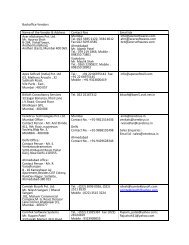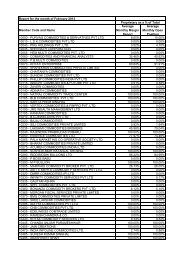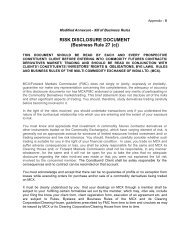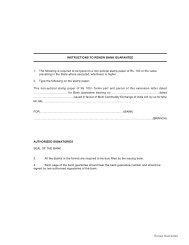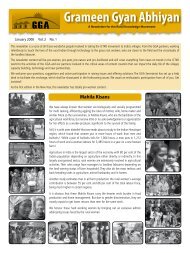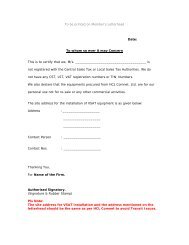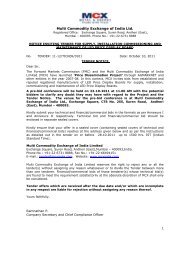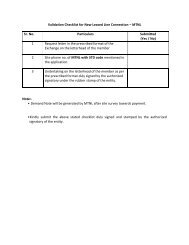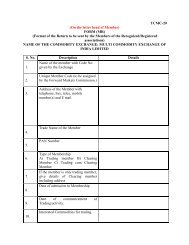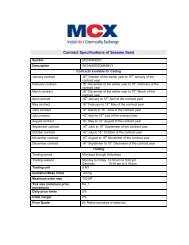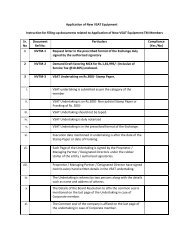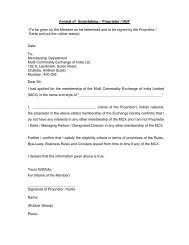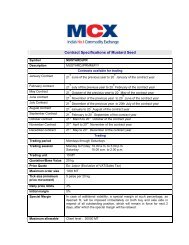Introduction, Contents, Foreword, From the Editorial Desk ... - MCX
Introduction, Contents, Foreword, From the Editorial Desk ... - MCX
Introduction, Contents, Foreword, From the Editorial Desk ... - MCX
Create successful ePaper yourself
Turn your PDF publications into a flip-book with our unique Google optimized e-Paper software.
A<br />
Joint Endeavour<br />
CommoditY insights<br />
Yearbook 2010<br />
A bAnk of ExCLuSIvE knowLEdgE And<br />
InforMAtIon on CoMModItIES ECoSyStEM<br />
Global Products<br />
Global Practices<br />
Sponsors
introduction<br />
About Commodity Insights<br />
The idea behind ‘Commodity Insights’, a bank<br />
of exclusive knowledge and information on<br />
commodities ecosystem jointly published by <strong>the</strong><br />
Multi Commodity Exchange of India and PricewaterhouseCoopers,<br />
is to provide readers/users<br />
(economic stakeholders like traders, processors,<br />
consumers, financial institutions, policymakers,<br />
analysts, industry observers, academicians, and<br />
students) with rare insights into <strong>the</strong> commodities<br />
ecosystem. This is our small second step in making<br />
this yearbook a benchmark resource spreading<br />
knowledge and providing very useful market<br />
information in one place in a novel way: presenting<br />
useful data related to commodity markets in an<br />
easy-to-use way and a rich repertoire of analytical<br />
articles to portray an all-inclusive, up-to-date and<br />
lucid exposition of a range of issues and concerns<br />
that are of paramount importance to healthy<br />
development of <strong>the</strong> entire ecosystem.<br />
The focal point of <strong>the</strong> second edition, ‘Commodity<br />
Insights Yearbook 2010’, is ‘Global<br />
Products, Global Practices’. Towards this goal, we<br />
have sought to achieve keen involvement of internationally<br />
acclaimed authors who all are experts as<br />
well as prolific writers in <strong>the</strong>ir respective domain,<br />
especially in <strong>the</strong> areas of policymaking and ideation.<br />
Besides, our value-adds this year will include<br />
specific case studies on ‘oil hedging and metals price<br />
risk management’, data on ‘BRIC economies’, data<br />
giving a broad perspective global economy, etc.<br />
The yearbook, we promise, will be truly useful to<br />
all stakeholders as a year-long, one-stop reference<br />
material. A fascinating and engaging read too!<br />
2 | Commodity Insights Yearbook 2010
About PwC<br />
PwC refers to <strong>the</strong> network of member firms of<br />
PricewaterhouseCoopers International Limited, each<br />
of which is a separate and independent legal entity<br />
committed to working toge<strong>the</strong>r to consistently provide<br />
clients seamless services of high standards, giving<br />
PwC a competitive edge. More than 161,000 people<br />
(over 6,000 in India) in 154 countries across <strong>the</strong> PwC<br />
network share <strong>the</strong>ir thoughts, experience and solutions<br />
to develop fresh perspectives and practical advice. The<br />
130-year old Indian firm – PricewaterhouseCoopers Pvt.<br />
Ltd. (www.pwc.com/India) – is <strong>the</strong> oldest and largest<br />
professional services firm that offers a comprehensive<br />
portfolio of Advisory and Tax & Regulatory services,<br />
each presenting a basket of finely defined deliverables.<br />
With a global outlook and local knowledge of culture,<br />
laws and business needs, PwC through its solutions to<br />
<strong>the</strong> challenges of globalization helps clients in India<br />
make <strong>the</strong> most of <strong>the</strong> changing market scenario. In<br />
India, PwC has offices in nine cities – Ahmedabad,<br />
Bangalore, Bhubaneshwar, Chennai, Delhi NCR,<br />
Hyderabad, Kolkata, Mumbai, and Pune.<br />
About <strong>MCX</strong><br />
Multi Commodity Exchange of India (<strong>MCX</strong>) is a<br />
demutualised commodity exchange with permanent<br />
recognition from <strong>the</strong> Government of India to facilitate<br />
online trading, clearing and settlement operations for<br />
commodity futures markets across <strong>the</strong> country. Since<br />
its inception in November 2003, millions of small<br />
and medium enterprises, corporate houses, exporters,<br />
importers and traders have benefitted from this<br />
nationwide electronic trading platform through its<br />
efficient and transparent price discovery and price risk<br />
management. <strong>MCX</strong> is <strong>the</strong> sixth largest commodity<br />
exchange in <strong>the</strong> world and ranks No. 1 in silver, No. 2<br />
in gold and natural gas, and No. 3 in crude oil and zinc<br />
futures trading (by <strong>the</strong> number of contracts traded),<br />
according to FIA and data on exchanges’ websites.<br />
A PwC & <strong>MCX</strong> Joint Endeavour | 3
<strong>Contents</strong><br />
<strong>Foreword</strong> ....................................................................................07<br />
<strong>From</strong> <strong>the</strong> <strong>Editorial</strong> <strong>Desk</strong> ................................................... 08<br />
Market Commentary:<br />
Commodity Markets – Poised to unlock value for <strong>the</strong><br />
stakeholders ...............................................................................10<br />
Experts’ Views:<br />
Commodity Exchanges: Role in a Globalising Economy<br />
- Jeffrey M. Christian .................................................................18<br />
Lessons from <strong>the</strong> Crisis: Future of Financial Regulation<br />
and Global Imbalances - Partha Ray .................................22<br />
Mumbai as an IFC – Role of Commodity Exchanges<br />
- Ashima Goyal ..........................................................................30<br />
Inter-Relation between Different Markets – Lessons for<br />
Commodities - Adam Gross ...................................................38<br />
Price Risk Management Instruments in Agriculture<br />
- Panos Varangis ........................................................................ 46<br />
Commodity Exposures – Best Practice Treatment for<br />
Hedge Accounting - Blaik Wilson ........................................52<br />
Carbon Markets: The Post-Copenhagen Scenario<br />
- Pamposh Bhat .......................................................................... 60<br />
Every effort has been made to ensure <strong>the</strong> high quality and accuracy of <strong>the</strong> content of <strong>the</strong> Yearbook. Under no circumstances, <strong>MCX</strong> and/or<br />
PwC shall not be liable to any user for unintended/accidental errors. The opinions/views expressed and shared by domain experts/authors<br />
in all documented materials are <strong>the</strong>ir own and do not necessarily reflect those of <strong>the</strong> organisations/institutions <strong>the</strong>y bear allegiance to,<br />
<strong>MCX</strong>, or PwC (<strong>the</strong> views shared by Jeffrey M. Christian, MD and Founder - CPM Group, are both his and <strong>the</strong> Group’s). Users/readers may<br />
carry out due diligence before using any data/information herein; nei<strong>the</strong>r <strong>MCX</strong> nor PwC will be responsible for any discrepancies/disputes<br />
arising out of such use.<br />
4 | Commodity Insights Yearbook 2010
Wea<strong>the</strong>r Derivatives: A Key Tool for Mitigating <strong>the</strong><br />
Impact of Climate Change – Rajas Parchure ................... 64<br />
Metal Price Risks – A New Reality - Jeffrey Bollebakker &<br />
Arnab Ghosh ................................................................................70<br />
Gas Pricing in India – Changing Contours<br />
- Deepak Mahurkar ....................................................................78<br />
Special Feature:<br />
Currency Futures - A Key to Managing Exchange<br />
Rate Risk .....................................................................................58<br />
Market Data for Ready Reference:<br />
Indian Economy - An overview ...........................................92<br />
Non-Agricultural Commodities .........................................132<br />
Agricultural Commodities ................................................. 226<br />
Emerging Commodities – Managing Price Risks for<br />
India Inc - Pankaj Chandak .....................................................86<br />
All rights reserved. No part of this publication may be reproduced, or transmitted in any form or by any means, electronic, mechanical,<br />
photocopying, recording, scanning, or o<strong>the</strong>rwise, without explicit prior permission of <strong>MCX</strong> or PwC.<br />
A PwC & <strong>MCX</strong> Joint Endeavour | 5
Tel. : +91-11-23782807<br />
+91-11-23070121<br />
Fax : +91-11-23384716<br />
e-mail: secy-ca@nic.in<br />
RAJIV AGARWAL<br />
Secretary<br />
Yeejle mejkeÀej<br />
GHeYeeskeÌlee ceeceues, KeeÐe SJeb meeJe&peefvekeÀ efJelejCe ceb$eeue³e<br />
GHeYeeskeÌlee ceeceues efJeYeeie<br />
ke=Àef
from <strong>the</strong> EDIToRIAL DESK<br />
Reaching Out<br />
to enrich <strong>the</strong> Ecosystem…<br />
In our continued commitment to<br />
enriching <strong>the</strong> commodity markets<br />
ecosystem, it is our pleasure<br />
to have joined hands once again<br />
to bring out <strong>the</strong> second edition of<br />
‘Commodities Insights Yearbook’.<br />
In line with <strong>the</strong> Multi Commodity<br />
Exchange’s stated focus on “global<br />
commodities and global practices”,<br />
we have reached out to some international<br />
experts, specialists in <strong>the</strong>ir<br />
respective domains, to contribute<br />
to <strong>the</strong> first part of <strong>the</strong> yearbook<br />
dedicated to continuous knowledge<br />
sharing and enrichment. The result<br />
of this knowledge delivery process<br />
is inside – for all stakeholders to<br />
read and benefit from. The experts’<br />
contributions cover multiple dimensions<br />
of commodity markets, from<br />
risk management in commodities/<br />
verticals to global best practices in<br />
markets and among <strong>the</strong>ir heterogeneous<br />
stakeholders to <strong>the</strong> role<br />
commodity exchanges can play in<br />
making Mumbai an International<br />
Financial Centre.<br />
Thanks to <strong>the</strong> warm response various<br />
ecosystem stakeholders and <strong>the</strong><br />
users of this yearly compendium<br />
have extended to our endeavour<br />
with <strong>the</strong>ir candid feedback, we have<br />
taken sincere efforts to provide an<br />
increased number of useful data<br />
sets on commodities and improve<br />
Standing (from left to right): Mr. Niteen Jain, Mr. Sujan Bhattacharyya, Ms. Vidya Shintre, Ms. Dhwani Mehta, Mr. Nazir Ahmed Moulvi, and Mr. Debojyoti Dey.<br />
Seated (from left to right): Dr. Kiran Karande, Ms. Carol Daver, and Dr. V. Shunmugam
<strong>the</strong> overall quality of <strong>the</strong> book<br />
based on <strong>the</strong>ir feedback.<br />
Having won several credentials<br />
in its journey to becoming India’s<br />
largest and <strong>the</strong> world’s sixth largest<br />
commodity exchange, driven<br />
by its strategic partnerships with<br />
various ecosystem players, it was<br />
time for <strong>MCX</strong> to focus on creating<br />
a global benchmark platform with<br />
worldwide-traded commodities,<br />
which would follow global benchmark<br />
practices to provide domestic<br />
economic stakeholders with a costeffective<br />
platform to mitigate <strong>the</strong><br />
forces of international commodity<br />
fundamentals in Indian time zone.<br />
priate guidance in <strong>the</strong>ir future<br />
decisions ranging from personal<br />
consumption to national economic<br />
policymaking.<br />
In our bid to reach out to a wider<br />
base of stakeholders – and give <strong>the</strong>m<br />
access to <strong>the</strong> yearbook – than <strong>the</strong><br />
limitation of a printed edition allows<br />
us to, we have already hosted <strong>the</strong><br />
electronic version of <strong>the</strong> first edition<br />
of ‘Commodity Insights’ on <strong>the</strong><br />
exchange website, www.mcxindia.<br />
com. It draws an average of 411 visitors<br />
everyday and has attracted nearly<br />
56,680 hits since it was uploaded in<br />
May-end. To inform those who are<br />
new to this joint endeavour of <strong>MCX</strong><br />
and PwC, <strong>the</strong> first issue was released<br />
on October 14, 2009.<br />
We would like to thank Mr. Jignesh<br />
Shah, Vice Chairman – <strong>MCX</strong>;<br />
Mr. Lamon Rutten, MD and CEO<br />
– <strong>MCX</strong>; Mr. Parveen Singhal, DMD<br />
– <strong>MCX</strong>; and Mr. Kumar Dasgupta,<br />
Partner – Price Waterhouse; for <strong>the</strong>ir<br />
continuous encouragement and<br />
support without which this initiative<br />
of ours would have remained<br />
unaccomplished. We also would<br />
PwC, which services clients <strong>the</strong><br />
world over in <strong>the</strong>ir efforts towards<br />
price risk management of globallytraded<br />
commodities, becomes<br />
<strong>MCX</strong>’s natural partner in this joint<br />
endeavour aimed at enlightening<br />
market participants, academicians,<br />
corporations, and policymakers<br />
with prices and <strong>the</strong> fundamentals<br />
that shape <strong>the</strong>m. We firmly believe<br />
that this effort of ours will help<br />
all <strong>the</strong>se stakeholders with approlike<br />
to thank Sujan Bhattacharyya,<br />
Niteen Jain, Nazir Moulvi, Dhwani<br />
Mehta and Debojyoti Dey, all from<br />
<strong>MCX</strong>, and Dr. Kiran Karande from<br />
Price Waterhouse for <strong>the</strong>ir relentless<br />
efforts, day in and day out, without<br />
which our idea would not have<br />
taken <strong>the</strong> shape of this book. It is our<br />
pleasure to acknowledge <strong>the</strong> work<br />
of summer interns from SCMHRD,<br />
Pune – Ms. Arshika Mishra, Mr.<br />
Ankit Dua and Mr. L. Deepak – on<br />
updating <strong>the</strong> data sets published in<br />
<strong>the</strong> 2009 edition. And finally, this<br />
message from <strong>the</strong> editorial desk will<br />
not be complete without thanking<br />
Ms. Carol Daver and Ms. Vidya<br />
Shintre who helped ga<strong>the</strong>r financial<br />
support for packaging this idea of<br />
ours in a most presentable manner.<br />
You may share your views,<br />
thoughts, and suggestions with<br />
us at ci@mcxindia.com, or at <strong>the</strong><br />
email addresses provided below;<br />
this surely will help us enrich<br />
‘Commodity Insights’ even fur<strong>the</strong>r<br />
in future attempts.<br />
Hope, you find this edition worth<br />
referring to, time and again.<br />
V. Shunmugam<br />
Chief Dr. V Sunmugam Economist<br />
Multi Commodity Exchange of India<br />
Kumar Dasgupta<br />
Dr. V Sunmugam<br />
Kumar Dasgupta<br />
Partner<br />
Kumar Dasgupta<br />
Price Waterhouse<br />
A PwC & <strong>MCX</strong> Joint Endeavour | 9
market CoMMENTARY<br />
Commodity Markets –<br />
Poised to unlock value<br />
for <strong>the</strong> stakeholders<br />
With gradual realisation and acceptance by<br />
economic stakeholders that in order to take<br />
necessary commercial decisions, <strong>the</strong>y have to<br />
factor in global (not just domestic) availability<br />
and prices of commodities, <strong>the</strong>re has also been<br />
a tacit recognition of <strong>the</strong> necessity of protecting<br />
commercial operations from <strong>the</strong> risks posed by<br />
high price volatility at <strong>the</strong> international level. An<br />
Ernst and Young survey in 2008 found that <strong>the</strong>re<br />
has been an overwhelming recognition of risks<br />
stemming from commodity price fluctuations<br />
and, thus, of <strong>the</strong> importance of hedging of inputs<br />
at pre-fixed prices as a risk-mitigating strategy.<br />
However, our markets, which are mature enough<br />
to unlock values for <strong>the</strong> stakeholders, now<br />
need an enabling environment that is based on<br />
imaginative and bold policy agenda.<br />
For reasons with multiple<br />
implications, commodities<br />
have been in <strong>the</strong> news for much<br />
of <strong>the</strong> period since ‘Commodities<br />
Insights’ made its appearance last<br />
autumn. Although much water<br />
has flown since <strong>the</strong>n, commodities<br />
with <strong>the</strong>ir varied economic dimensions<br />
have come to visit us more<br />
often, at times with a greater force<br />
than before. With globalisation of<br />
<strong>the</strong> Indian economy, nearly all<br />
its players – from tractor-driving<br />
farmers to jet-flying corporates –<br />
are getting exposed to <strong>the</strong> vagaries<br />
of international fundamentals<br />
affecting commodities that <strong>the</strong>y<br />
are concerned with. Whe<strong>the</strong>r<br />
<strong>the</strong> Indian economy is truly ‘decoupled’<br />
from <strong>the</strong> forces driving<br />
economies elsewhere in <strong>the</strong> world<br />
or not, particularly during a crisis<br />
scenario like <strong>the</strong> current one, our<br />
10 | Commodity Insights Yearbook 2010
market CoMMENTARY<br />
domestic commodity markets,<br />
undeniably, are linked to <strong>the</strong><br />
global fundamentals of demand,<br />
supply, policy actions and market<br />
expectations much more now than<br />
ever before.<br />
New global risks and<br />
increasing recognition<br />
of hedging<br />
With gradual realisation and acceptance<br />
by <strong>the</strong> country’s economic<br />
stakeholders that both global availability<br />
and prices of international<br />
commodities have to be factored<br />
in, to take <strong>the</strong> necessary production<br />
and o<strong>the</strong>r commercial decisions,<br />
<strong>the</strong>re is also a tacit recognition<br />
of <strong>the</strong> necessity of shielding <strong>the</strong>ir<br />
commercial operations from risks<br />
posed by commodity price volatility<br />
at <strong>the</strong> international level. A<br />
2008 survey by Ernst and Young<br />
(E&Y) across a broad range of<br />
Indian companies found that <strong>the</strong>re<br />
has been overwhelming recognition<br />
of <strong>the</strong> risks arising out of commodity<br />
price fluctuations and, thus,<br />
that of <strong>the</strong> importance of hedging<br />
of inputs at pre-fixed prices as a<br />
risk-mitigating strategy as per <strong>the</strong><br />
responses of most of <strong>the</strong> surveyed<br />
lot. Yet, protection against adverse<br />
commodity price movements is<br />
viewed more as a tactical measure<br />
than as a strategic device to manage<br />
risks.<br />
The effect of price volatility of various<br />
commodities on corporate bottom<br />
lines was amply demonstrated<br />
by a recent study carried out by a<br />
prominent Indian business daily.<br />
The study used quarterly results<br />
of over 1,500 manufacturing firms,<br />
which indicated that expenses on<br />
‘raw material’ had increasingly<br />
eaten away a higher share of <strong>the</strong><br />
o<strong>the</strong>rwise healthy performance of<br />
<strong>the</strong>ir sales.<br />
As <strong>the</strong> table shows, raw material<br />
expenses, which had, in fact,<br />
declined by 3.19% in December<br />
2009, increased by 59% in March<br />
2010 and 28 percent in June 2010<br />
for this large sample of companies.<br />
The expenses also consistently<br />
accounted for more than half <strong>the</strong><br />
sales since March 2010. Consequently,<br />
net profits of <strong>the</strong>se companies<br />
have been falling consistently<br />
over <strong>the</strong> past three quarters. And<br />
this is despite <strong>the</strong>ir net sales successfully<br />
wea<strong>the</strong>ring adverse world<br />
economic conditions to post robust<br />
year-on-year growth.<br />
Perhaps <strong>the</strong> companies could do<br />
pretty little to reduce <strong>the</strong>ir raw<br />
material bill. But what <strong>the</strong>y could<br />
have definitely done is to arrest<br />
<strong>the</strong> impact of commodity price<br />
volatility and, by extension, <strong>the</strong><br />
volatility in <strong>the</strong>ir net profits. As<br />
<strong>the</strong> table shows, increases in net<br />
profits gyrated wildly from 67.40%<br />
to 11.48% during <strong>the</strong> last three<br />
quarters. Evidently, a robust risk<br />
management tool like commodity<br />
futures trading to hedge against<br />
such volatility could have enabled<br />
<strong>the</strong>m to lock in input costs at predetermined<br />
levels. This, sadly, was<br />
not done to <strong>the</strong> desired extent by<br />
<strong>the</strong>se companies, a result of failure<br />
to take risk management from<br />
tactical to strategic levels by <strong>the</strong>ir<br />
management. What also added to<br />
<strong>the</strong>ir woes is lack of a policy and<br />
institutional environment that<br />
could promote risk management<br />
culture among <strong>the</strong>m.<br />
A similar survey of 1,100 companies,<br />
after <strong>the</strong>ir March 2010 quarter<br />
results were announced, was conducted<br />
by ano<strong>the</strong>r publication. The<br />
combined net profits of <strong>the</strong>se companies<br />
showed a marked increase<br />
of 28.5%, year on year. However, if<br />
<strong>the</strong> commodity companies (merely<br />
155 in all) were left out, <strong>the</strong> net<br />
profits of <strong>the</strong> rest fell by more<br />
than 9 percentage points to 19.8%!<br />
Conversely, <strong>the</strong> quarterly profits of<br />
<strong>the</strong>se 155 commodity companies<br />
grew by more than 103%, Y-o-Y, in<br />
March 2010, proving <strong>the</strong> dichotomous<br />
effect of commodity prices<br />
on corporate bottom lines.<br />
effect of commodity prices on corporate bottomlines<br />
Heads June ‘10 March ‘10 December ‘09<br />
Rs. /crore % change Rs. /crore % change Rs. /crore % change<br />
over over over<br />
June ‘09 March ‘09 Dec. ‘08<br />
Net sales 418,814 23.07 448,346 30.09 401,200 19.18<br />
Raw Mat. Expense 210,731 27.63 235,468 58.94 159,284 (-)3.19<br />
Raw Mat to sales (%) 50.32 1.80 52.52 9.53 39.70 (-)9.17<br />
Net Profit 43,419 11.48 47,649 40.92 48,218 67.40<br />
Source: Capitaline<br />
For an economy trying to wi<strong>the</strong>r<br />
<strong>the</strong> effects of <strong>the</strong> recent financial<br />
crisis on its foreign trade prospects,<br />
commodity price volatility has<br />
been a double whammy for its<br />
agriculture sector in <strong>the</strong> past one<br />
year. Such high volatility is, again,<br />
a result of Indian agricultural<br />
markets responding to signals emanating<br />
from international markets<br />
in an increasingly globalised world<br />
where rapid strides in information<br />
and communication technology<br />
(ICT) mean that <strong>the</strong> smallest news<br />
of relevance in <strong>the</strong> remotest part<br />
of <strong>the</strong> world can have its profound<br />
effect felt within domestic markets<br />
and that <strong>the</strong>re remains a structural<br />
12 | Commodity Insights Yearbook 2010
Healthy market growth<br />
– in need of policy<br />
initiatives<br />
Markets facilitating <strong>the</strong> trade in<br />
commodity-based derivatives in<br />
India are regulated under <strong>the</strong> Forcorrection<br />
of prices pending for<br />
long. The double whammy is due<br />
to volatility adversely impacting<br />
food prices and input costs and,<br />
thus, <strong>the</strong> bottom lines of industries<br />
using <strong>the</strong>m as raw materials. The<br />
state machinery often tries to<br />
intervene in <strong>the</strong> market to cushion<br />
both sides of <strong>the</strong> market by absorbing<br />
such volatility often at <strong>the</strong> cost<br />
of <strong>the</strong> exchequer.<br />
The moot point is that risks associated<br />
with commodity price spikes<br />
and volatility have, in recent times,<br />
risen considerably and affected<br />
more and more economic entities<br />
that are being exposed to risks<br />
associated with increasing volatility<br />
while being ever more aware of<br />
<strong>the</strong> impact of this exposure on <strong>the</strong>ir<br />
economic pursuits. While <strong>the</strong>y<br />
seek to cover <strong>the</strong>se risks through<br />
hedging against commodity price<br />
movements, how attractive does<br />
<strong>the</strong> market <strong>the</strong>y approach appear.<br />
The E&Y survey found nearly all<br />
respondents to hedge through<br />
recourse to plain vanilla products<br />
alone. Significantly, about 68% of<br />
<strong>the</strong>m had a hedging horizon of less<br />
than three months, indicating that<br />
<strong>the</strong>y could not explore possibilities<br />
of long-term hedging to protect<br />
long-term business cash flows.<br />
Clearly, <strong>the</strong>re is a demand for<br />
safe hedging through a variety of<br />
hedging instruments, many more<br />
than what <strong>the</strong> market currently<br />
provides. While OTC forward<br />
contracts can fulfil <strong>the</strong> demand<br />
for customised hedging products,<br />
<strong>the</strong>y lack <strong>the</strong> kind of liquidity<br />
and safety that exchange-traded<br />
and exchange-cleared derivatives<br />
provide. The market for <strong>the</strong> latter,<br />
unfortunately, seems to have<br />
run into a wall as <strong>the</strong> supply of<br />
67.4%<br />
To 11.5% – Companies’<br />
net profits gyrated, as<br />
wildly as this, in <strong>the</strong> past 3<br />
quarters. Surely, a robust risk<br />
management tool like commodity<br />
futures could have helped<br />
lock in input costs at<br />
predetermined<br />
levels.<br />
products has scarcely been able to<br />
match <strong>the</strong>ir ability and needs. The<br />
reason, as has been elucidated in<br />
several fora by several constituencies<br />
in recent years, is <strong>the</strong> slow pace<br />
of policy and institutional reforms<br />
for nurturing <strong>the</strong> use of commodity<br />
derivatives by <strong>the</strong> stakeholders<br />
in India.<br />
A PwC & <strong>MCX</strong> Joint Endeavour | 13
market CoMMENTARY<br />
ward Contracts (Regulation) Act,<br />
1952, an Act enacted in <strong>the</strong> backdrop<br />
of wartime shortages. Evidently, a<br />
market which has grown by nearly<br />
40% in <strong>the</strong> past four years to become<br />
one of <strong>the</strong> largest in <strong>the</strong> world<br />
(implying its enormous importance<br />
for <strong>the</strong> economy) and its products<br />
are reckoned as an investible asset<br />
class in <strong>the</strong> league of stocks and<br />
fixed income instruments, needs<br />
to function under <strong>the</strong> ambit of a<br />
market-enabling regime than this<br />
Act allows. The intended amendment<br />
to <strong>the</strong> Act is yet to see <strong>the</strong><br />
light of day, despite being at various<br />
stages of review by legislators for<br />
close to four years. As a result, not<br />
only is market development, incommensurate<br />
to <strong>the</strong> level of economic<br />
requirement being impossible to be<br />
taken up under <strong>the</strong> existing law but<br />
also that integration of <strong>the</strong> commodity<br />
futures market with <strong>the</strong><br />
physical ecosystem has been left<br />
incomplete. The reluctance of both<br />
capital and money market regulators<br />
to let <strong>the</strong>ir regulated entities<br />
enter <strong>the</strong> commodity futures market<br />
appears to be for two broad reasons:<br />
<strong>the</strong> lack of clear policy guidelines<br />
and <strong>the</strong> absence of an autonomous<br />
regulator for this market. Similarly,<br />
denying products such as options<br />
and intangibles, which could fulfil<br />
<strong>the</strong> hedging demand of a very large<br />
number of stakeholders – not <strong>the</strong><br />
least of who are from <strong>the</strong> farming<br />
community – is tantamount to<br />
keeping <strong>the</strong>se stakeholders away<br />
from an effective risk-mitigating<br />
device.<br />
That economic stakeholders are<br />
more prone to commodity price<br />
risks under effect of global forces<br />
has been well recognized by now.<br />
This has been <strong>the</strong> biggest contributor<br />
to <strong>the</strong> creation of <strong>the</strong> demand<br />
side of <strong>the</strong> commodities derivatives<br />
market. What has been less appreciated<br />
is <strong>the</strong> tremendous potential<br />
that a fast-growing large economy<br />
like India holds in <strong>the</strong> world of<br />
commodities market to get back<br />
its ancient price-setting power.<br />
Given <strong>the</strong> size of its population and<br />
nature and growth potential of its<br />
economy, India is one of <strong>the</strong> largest<br />
producers and/or consumers of<br />
most commodities. With liberalised<br />
markets – both physical and futures<br />
- and an accommodative policy<br />
regime that promotes new products<br />
and market participation from India<br />
and abroad, <strong>the</strong> commodity derivatives<br />
market in India can set global<br />
benchmarks not only in terms of<br />
prices discovered in its markets<br />
but also in terms of products and<br />
practices. Already, despite being<br />
under a relatively restrictive market,<br />
<strong>the</strong> country’s largest commodity<br />
futures exchange is <strong>the</strong> sixth largest<br />
in <strong>the</strong> world, occupying <strong>the</strong> top<br />
position in silver and second position<br />
in gold and natural gas. With<br />
an accommodative policy, India<br />
can definitely be <strong>the</strong> price-maker<br />
ra<strong>the</strong>r than a passive price-taker<br />
for most commodities in <strong>the</strong> world<br />
market, especially <strong>the</strong> ones that <strong>the</strong><br />
stakeholders actively trade in. Such<br />
policies would not only include<br />
Courage is not<br />
<strong>the</strong> absence of<br />
fear, but ra<strong>the</strong>r<br />
<strong>the</strong> judgment<br />
that something<br />
else is more<br />
important<br />
than fear<br />
Ambrose Redmoon<br />
those that promote futures trading<br />
in commodities but also remove <strong>the</strong><br />
hurdles on <strong>the</strong> way towards formation<br />
of a pan-India physical market<br />
for commodities setting up a solid<br />
platform for national commodity<br />
derivative markets.<br />
Today, as we stand at <strong>the</strong> cusp of<br />
history and a generation witnesses<br />
<strong>the</strong> transition of India from a<br />
poverty-stricken country to one<br />
of prosperity and economic might,<br />
<strong>the</strong> visages of control that inhibit<br />
this transition have to be identified<br />
and removed. Cynics argue against<br />
liberalising commodity markets for<br />
a range of imaginary fears, ranging<br />
from stoking fires of inflation to<br />
securing supplies of key intermediaries.<br />
But as our experience<br />
with liberalisation (toge<strong>the</strong>r with<br />
similar actions of <strong>the</strong> o<strong>the</strong>r emerging<br />
superpower, China) has clearly<br />
demonstrated, <strong>the</strong>re is much more<br />
to gain through liberalisation of<br />
markets and economy than to give<br />
into what <strong>the</strong> phantoms of imagination<br />
would lead us to believe.<br />
After all, <strong>the</strong> Indian economy has<br />
proven to be robust enough to<br />
withstand and emerge successfully<br />
from transitions and crises; and<br />
markets, under leadership-providing<br />
regulators, mature enough to<br />
unlock values for <strong>the</strong> economic<br />
stakeholders. What is needed now<br />
is only an enabling environment,<br />
created by an imaginative and bold<br />
policy agenda, so that <strong>the</strong>se values<br />
are reaped by all stakeholders to<br />
<strong>the</strong>ir fullest extent. As American<br />
writer Ambrose Redmoon once<br />
famously said, “Courage is not<br />
<strong>the</strong> absence of fear, but ra<strong>the</strong>r <strong>the</strong><br />
judgment that something else is<br />
more important than fear”, only<br />
some boldness in policymaking and<br />
a commitment towards fur<strong>the</strong>r<br />
liberalisation of economic forces<br />
can catapult us to <strong>the</strong> next level<br />
of growth<br />
14 | Commodity Insights Yearbook 2010
PricewaterhouseCoopers Pvt. Ltd.<br />
2nd Floor, 252, Veer Savarkar Marg, Shivaji Park, Dadar, Mumbai 400 028 (India)<br />
Phone: +91-22-6669 1000; Fax: +91-22-6654 7800<br />
Website: www.pwc.corn<br />
Multi Commodity Exchange of India Ltd.<br />
Exchange Square, CTS No. 255, Suren Road, Chakala, Andheri (East), Mumbai 400 093 (India)<br />
Tel: +91-22-6731 8888; Fax: +91-22-6649 4151<br />
Website: www.mcxindia.com



